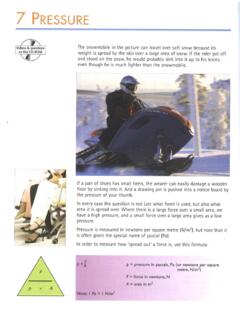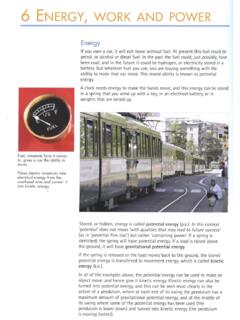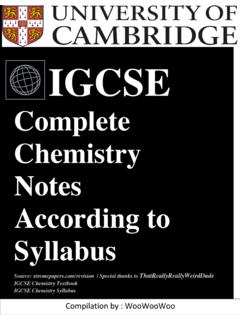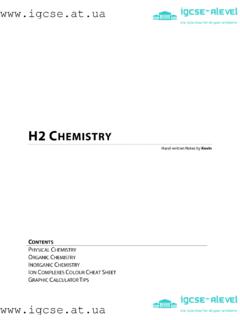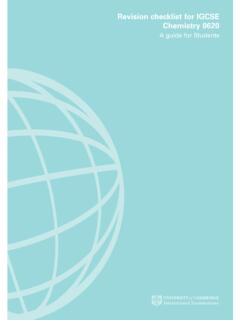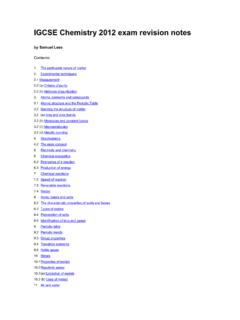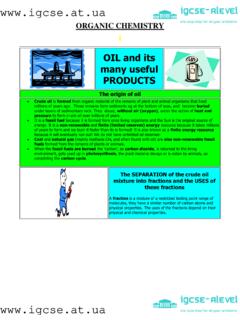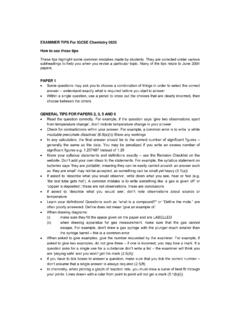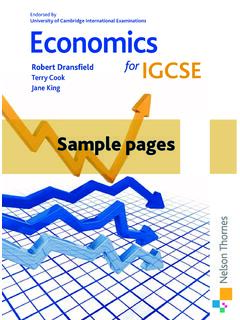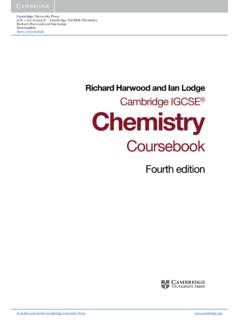Transcription of IGCSE CHEMISTRY AN INTERACTIVE REVISION GUIDE ANDREW ...
1 [ ANDREW RICHARD WARD ALL RIGHTS RESERVED A WARD TUITION - 2009] Page 1 IGCSE CHEMISTRY AN INTERACTIVE REVISION GUIDE ANDREW RICHARD WARD BSC PGCE MA(ED) MRSC ENDORSED BY THE ROYAL SOCIETY OF CHEMISTRY AND CAMBRIDGE EXAMINATIONS BOARD. CONTENTS [ ANDREW RICHARD WARD ALL RIGHTS RESERVED A WARD TUITION - 2009] Page 2 PRINCIPLES OF CHEMISTRY 1. PARTICULATE NATURE OF MATTER 2. EXPERIMENTAL TECHNIQUES 3. ATOMS, ELEMENTS AND COMPOUNDS 4. STOICHIOMETRY PHYSICAL CHEMISTRY 5. ELECTRICITY AND CHEMISTRY 6. CHEMICAL CHANGES 7. CHEMICAL REACTIONS 8. ACIDS, BASES AND SALTS INORGANIC CHEMISTRY 9. THE PERIODIC TABLE 10. METALS 11. AIR AND WATER 12. SULPHUR 13. CARBONATES ORGANIC CHEMISTRY 14. ORGANIC CHEMISTRY INTRODUCTION [ ANDREW RICHARD WARD ALL RIGHTS RESERVED A WARD TUITION - 2009] Page 3 THIS STUDY GUIDE IS A REVISION GUIDE IT IS NOT A TEXTBOOK IT IS TO BE USED ALONGSIDE A TEXT BOOK AND CLASSROOM notes AS A REFERENCE TEXT TO HELP WITH EXAM REVISION THE ESSENTIAL FACTS NEEDED FOR CHEMISTRY AT IGCSE ARE SUMMARIZED WITH A MINIMUM OF FUSS AND MAXIMUM EFECT MR.
2 WARD HAS BEEN A SECONDARY TEACHER OF SCIENCE, MATHEMATICS AND ICT SINCE 1992. MR. WARD IS A GRADUATE OF UNIVERSITIES IN THE NORTH EAST OF ENGLAND WHERE HE OBTAINED HIS BACHELORS AMD MASTERS DEGREES. MR. WARD IS CURRENTLY STUDYING FOR HIS DOCTORATE OF EDUCATION AT LONDON UNIVERSITY, ENGLAND WHERE HE IS SPECIALIZING IN THE USE OF MIND-MAPPING TO ENHANCE SCIENCE EDUCATION. MR. WARD CAN BE CONTACTED ON 66735119 AND BY EMAIL AT [ ANDREW RICHARD WARD ALL RIGHTS RESERVED A WARD TUITION - 2009] Page 4 THIS GUIDE CONTAINS NEARLY 300 PAGES AND IS THE MOST CONCISE AND ONLY ELECTRONIC GUIDE TO CHEMISTRY CURRENTLY AVAILABLE IN KUWAIT MAXIMUM EFFECT MINIMUM notes MAXIMUM GRADES NON SCHOLAE SED VITAE DISCIMUS IT IS NOT FOR SCHOOL BUT FOR LIFE IN MEMORY OF MARY PATTISON 1918 1988. MY GUIDING LIGHT WHO IS ALWAYS LOVED AND NEVER FORGOTTEN. [ ANDREW RICHARD WARD ALL RIGHTS RESERVED A WARD TUITION - 2009] Page 5 TOPIC 1 ALL ABOUT MATTER CHEMISTRY is the study of matter Matter is all the substances and materials that the universe is made from.
3 There are many millions of known chemical substances. All can be classified as solid, liquid or gas. SOLID Definite fixed shape and volume Increase in size when heated expand Decrease in size when cooled contract LIQUID Has a fixed volume Takes up shape of container it is poured into Liquids slightly expand when heated also Can be compressed volume gets smaller when pressure added GAS No fixed shape or volume Takes up shape of container it is placed into and expands evenly within it Very noticeable change in volume when the temperature is increased. Gases are much more easy to compress than liquids KINETIC THEORY OF MATTER Explains the way in which matter behaves. The kinetic theory tells us all matter is made from PARTICLES. Kinetic theory explains the physical properties of matter in terms of the way that the particles move. [ ANDREW RICHARD WARD ALL RIGHTS RESERVED A WARD TUITION - 2009] Page 6 There are 3 main points to the Kinetic Theory: All matter is made from invisible tiny particles.
4 The particles can be called atoms, molecules or ions and can be different sizes. The particles move all of the time. High temperature = fast movement At any temperature, heavier particles move slower than lighter ones. DESCRIPTION OF PARTICLES IN SOLID, LIQUID AND GAS SOLID- Particles vibrate around fixed positions. Regular structure LIQUID- Particles have some freedom to move around each other. Many collisions GAS- Particles move freely and randomly in available space. Collide less than in liquid particles as far apart as possible CHANGES OF STATE Solid to liquid = melting Liquid to gas = boiling or evaporation Gas to liquid = condensation Liquid to solid = freezing Sometimes a solid may change directly into a gas missing out the liquid stage. This is called SUBLIMATION. Iodine is a black solid. It sublimes to form a purple gas. [ ANDREW RICHARD WARD ALL RIGHTS RESERVED A WARD TUITION - 2009] Page 7 Here is a table to show the melting point and boiling point of some chemical substances SUBSTANCE MELTING POINT(CELSIUS) BOILING POINT (CELSIUS) EXPLANATION Aluminium 661 2467 SOLID IT HAS NOT MELTED YET Ethanol -117 79 LIQUID MELTED AT LOW TEMPERATURE Magnesium oxide 2827 3627 SOLID NOT YET MELTED Mercury -30 357 LIQUID ALREADY MELTED Methane -182 -164 GAS ALREADY MELTED AND BOILED Oxygen -218 -183 GAS ALREADY MELTED AND BOILED [ ANDREW RICHARD WARD ALL RIGHTS RESERVED A WARD TUITION - 2009] Page 8 HEATNG AND COOLING CURVES Here is the heating curve for water (BY KIND PERMISSION OF THE BBC, UK) At the start, only ice is present.
5 After a bit, the curve goes flat. This means that even as we put heat energy in, the temperature stays the same. In ice, particles are close together and are attracted to one another. For ice to melt, the particles must get enough energy to overcome the forces of attraction in the water molecules to allow movement. This is where the heat energy is going. The temperature rises again after all of the ice has melted. The heating curve of a pure solid always stops rising at the melting point. A sharp melting point means a pure sample. ADDING IMPURITIES LOWERS MELTING POINT ICE CAN MELT AT -15 CELSIUS BY ADDING SALT TO IT. [ ANDREW RICHARD WARD ALL RIGHTS RESERVED A WARD TUITION - 2009] Page 9 If we want to boil the water, we have to give it extra energy. This can be seen on the graph when the curve levels out at 100 Celsius which is the boiling point of water. The reverse processes of condensation and freezing occur on COOLING. Energy is given out when the gas condenses to a liquid and the liquid freezes to a solid.
6 DIFFUSION DIFFUSION IS THE MOVEMENT OF PARTICLES FROM A REGION OF HIGH CONCENTRATION TO LOW CONCENTRATION DOWN A DIFFUSION GRADIENT. The diagram below shows how the diffusion of bromine molecules can be shown. Within 24 hours, the molecules of bromine spread out from a high concentration at the bottom of the gas jar and spread evenly throughout the total volume of the two gas jars. [ ANDREW RICHARD WARD ALL RIGHTS RESERVED A WARD TUITION - 2009] Page 10 Here is a sequence to show how molecules move down a diffusion gradient. The example chosen is for dissolving sugar in water: We will now consider Brownian Motion [ ANDREW RICHARD WARD ALL RIGHTS RESERVED A WARD TUITION - 2009] Page 11 BROWNIAN MOTION Robert Brown discovered this in 1827. This theory explains movement of particles in liquids. Brown discovered that pollen grains moved on the surface of water when he looked at them through a microscope. The grains were moving in RAPID RANDOM MOTION. This was later called BROWNIAN MOTION.
7 Here is a photograph of the Brownian Motion of particles when photographed under a microscope. You will see that the motion is rapid and random. [ ANDREW RICHARD WARD ALL RIGHTS RESERVED A WARD TUITION - 2009] Page 12 Photograph them with a microscope: Shows a pattern: [ ANDREW RICHARD WARD ALL RIGHTS RESERVED A WARD TUITION - 2009] Page 13 GAS LAWS This topic is studied in detail in Physics but is shown here for you to understand the behavior of gases in more detail: There are 2 gas laws which are important. They are named after the scientists who made their discoveries: BOYLE S LAW When we keep temperature the same, the volume of a fixed mass of gas is inversely proportional to the pressure. This means Large volume of gas = low pressure of gas Small volume of gas = high pressure of gas CHARLES LAW When we keep the pressure the same, the volume of a given mass of gas is directly proportional to the temperature. This means Large volume of gas = high temperature of gas Small volume of gas = low temperature of gas This is the end of chapter one.
8 A checklist of definitions is shown on the next page. You must be able to write them down by memory for your examinations. [ ANDREW RICHARD WARD ALL RIGHTS RESERVED A WARD TUITION - 2009] Page 14 TOPIC 1 CHECKLIST ABSOLUTE TEPERATURE This is the temperature measured with respect to absolute zero (zero Kelvin) on the Kelvin Scale. Temperature in Kelvin = Temperature in Celsius + 273 ATMOSPHERIC PRESSURE This is the pressure of the atmosphere on the surface of the Earth due to the weight of the air. BOILING POINT The temperature at which gas pressure above a liquid equals atmospheric pressure BOYLE S LAW At a constant temperature, the volume of a given mass of gas is inversely proportional to the pressure. V=1/p CHARLES LAW At constant pressure, the volume of a given mass of gas is directly proportional to absolute temperature. CONDENSATION This is the change of vapour of a gas into a liquid. This process involves heat being produced. DIFFUSION This is the process by which different substances mix because of the rapid random motion of their particles EVAPORATION This is a process that occurs at the surface of a liquid and involves the change of state of a liquid into a vapour at the temperature below boiling point.
9 [ ANDREW RICHARD WARD ALL RIGHTS RESERVED A WARD TUITION - 2009] Page 15 KINETIC THEORY A theory which accounts for the properties of materials in terms of constituent particles MATTER Anything that occupies space and has a mass MELTING POINT This is the temperature at which a solid starts to turn liquid. Pure substances have a sharp, defined melting point. SOLIDS, LIQUIDS AND GASES These are the three states of matter to which all substances belong SUBLIMATION The direct change of state from solid to gas or gas to liquid. [ ANDREW RICHARD WARD ALL RIGHTS RESERVED A WARD TUITION - 2009] Page 16 TOPIC 2: ELEMENTS, COMPOUNDS AND MIXTURES The name element was invented by Robert Boyle in 1661. Elements are made from only one type of atom. An element cannot be split into a simpler substance by any known chemical process. Atoms are tiny 20000000000000000 atoms = 1cm 115 elements have been identified. 24 have been artificially made by scientists like plutonium 91 are naturally occurring and can be found in the ground All elements can be classified as metals or non-metals The properties of metals and non-metals are different.
10 Here is a table to show the differences in the properties of metals and non-metals PROPERTY METAL NON-METAL Physical state at room temperature Usually solid (occasionally liquid like mercury) Solid, liquid or gas Malleability (can be beaten into sheets?) God No usually soft and brittle when solid Ductility (can be stretched into wires) Good No usually soft and brittle when solid Appearance as a solid Shiny Dull Melting point Usually high Usually low Boiling point Usually high Usually low Density Usually high Usually low Conductivity of heat and electricity Good Very poor [ ANDREW RICHARD WARD ALL RIGHTS RESERVED A WARD TUITION - 2009] Page 17 ATOMS Everything in the universe is made from billions of atoms. Atoms are too small to be seen by the eye. The smallest atom- hydrogen atoms are mm wide. Chemists use shorthand symbols to label elements and their atoms. Usually the first or first two letters of the name of the element are used. Some elements that were discovered many years ago still have Latin names like Sodium Na Latin name Natrium Lead Pb Latin name Plumbum MOLECULES The atoms of some elements are joined together in small groups called molecules.

